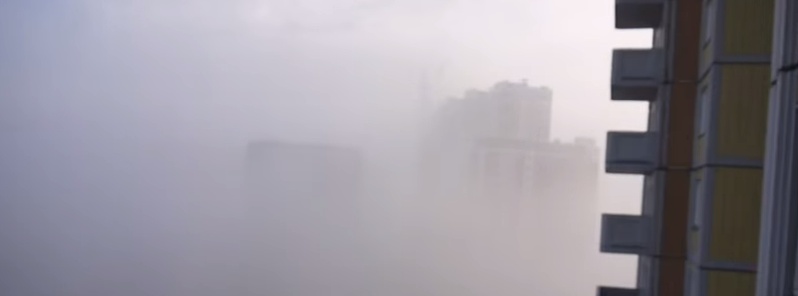“Toxic leak” causes massive cloud covering parts of Moscow

Authorities have urged residents of Moscow to stay indoors with their windows closed, after a smelly noxious fog was reportedly spreading through the parts of the city on Monday, November 10, 2014.
The smell has been detected in the south, east, and south-eastern parts of the Russian capital. According to some sources, about 4600 square kilometers (1892 sq. miles) wide area was covered judging by the huge response from the people reporting it from Zelenograd to Podolsk. The polluting cloud drifted from the south-east towards the center of Moscow.
According to Russian Hydro-Meteorological Service, the cloud first appeared in Moscow's south-east Lublino region early on November 10, where the concentration of hydrogen sulfide (H2S) has exceeded six times of normal levels. The concentrations of styrene and formaldehyde were also increased.
Hydrogen sulfide is a colorless gas with the characteristic foul odor of rotten eggs; it is heavier than air, very poisonous, corrosive, flammable, explosive and it collects in low lying areas. Several people have sought medical care because of strong headache and respiratory problems on Monday.
According to Head of the Emergencies Ministry Department for Moscow Alexander Yeliseyev, the pollutant content peaked over the safe level, but stabilized later. They even advised residents to open the windows and got outside safely, that the smell of hydrogen sulfide is not dangerous for the health of citizens.
The U.S. Embassy issued a warning on Monday afternoon urging U.S. citizens to remain indoors, close windows and doors, and turn off heating and cooling systems in order to reduce the flow of outside air.
Russia’s Emergencies Ministry eventually said the cause was a leak at a sulfur dioxide processor at an oil refinery outside town, according to Russian media reports. The chemicals discharged include hydrogen sulfide (H2S) and sulfur dioxide (SO2), both byproducts of oil processing.
Moscow City Goverment is cooperating with the Investigative Committee and the Prosecutor’s Office in investigating the Moscow Oil Refinery and other local plants.
Gazprom, which owns the refinery, has denied any accidents on site and stated that the plant is operating normally, according to the production plan.

Weather experts quoted in the Russian media say that the effects of the gas have been made worse because the current conditions in Moscow are "not conducive to the rapid dispersion of pollutants in the air". (BBC)
Deputy Minister Vladimir Stepanov said that insignificant excess of maximum permissible concentration of hydrogen sulfide – 1.5 and 2 times – which is over 800 times less than concentration dangerous for human health, had been registered in the east of Moscow. “There is nothing to worry about, however, the Emergencies Ministry recommends to reduce the time spent outside, though it has no effect on health”, Mr. Stepanov said. According to him the situation is normalizing. (EMERCOM)


Hydrogen sulfide (H2S)
Toxicity
Hydrogen sulfide is considered a broad-spectrum poison, meaning that it can poison several different systems in the body, although the nervous system is most affected. The toxicity of H2S is comparable with that of hydrogen cyanide or carbon monoxide. It forms a complex bond with iron in the mitochondrial cytochrome enzymes, thus preventing cellular respiration.
Since hydrogen sulfide occurs naturally in the body, the environment and the gut, enzymes exist in the body capable of detoxifying it by oxidation to (harmless) sulfate. Hence, low levels of hydrogen sulfide may be tolerated indefinitely. At some threshold level, believed to average around 300–350 ppm, the oxidative enzymes become overwhelmed.
Exposure to lower concentrations can result in eye irritation, a sore throat and cough, nausea, shortness of breath, and fluid in the lungs (pulmonary edema). These effects are believed to be due to the fact that hydrogen sulfide combines with alkali present in moist surface tissues to form sodium sulfide, a caustic. These symptoms usually go away in a few weeks.
Long-term, low-level exposure may result in fatigue, loss of appetite, headaches, irritability, poor memory, and dizziness. Chronic exposure to low level H2S (around 2 ppm) has been implicated in increased miscarriage and reproductive health issues among Russian and Finnish wood pulp workers, but the reports have not (as of circa 1995) been replicated.
Short-term, high-level exposure can induce immediate collapse, with loss of breathing and a high probability of death. If death does not occur, high exposure to hydrogen sulfide can lead to cortical pseudolaminar necrosis, degeneration of the basal ganglia and cerebral edema. Although respiratory paralysis may be immediate, it can also be delayed up to 72 hours. Read more…
Sulfur dioxide (SO2)
Sulfur dioxide is a noticeable component in the atmosphere, especially following volcanic eruptions.
Sulfur dioxide is a major air pollutant and has significant impacts upon human health. In addition, the concentration of sulfur dioxide in the atmosphere can influence the habitat suitability for plant communities, as well as animal life. Sulfur dioxide emissions are a precursor to acid rain and atmospheric particulates.
Inhaling sulfur dioxide is associated with increased respiratory symptoms and disease, difficulty in breathing, and premature death.
A 2011 systematic review concluded that exposure to sulfur dioxide is associated with preterm birth. Read more…
This page will be updated with latest information.

Commenting rules and guidelines
We value the thoughts and opinions of our readers and welcome healthy discussions on our website. In order to maintain a respectful and positive community, we ask that all commenters follow these rules.